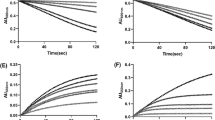Abstract—
The main goal of this work was a quantitative analysis of the kinetics of the formation of reactive oxygen species (ROS) by complex II of the mitochondrial respiratory chain. For this purpose, a mathematical model was developed for modeling and experimental studies of changes in mitochondria associated with ROS-induced activation of signaling pathways of cell death (apoptosis, necrosis, and necroptosis). A kinetic scheme of electron transfer from succinate to coenzyme Q through a number of redox centers localized in subcomplexes A, B, C, and D of complex II was developed on the basis of published experimental data. The mathematical model corresponding to the kinetic scheme is a system of 17 ordinary differential equations that describes both the concentration of oxidized and reduced states of various electron carriers and the electron flows in complex II, leading to the formation of ROS, superoxide (\({\text{O}}_{2}^{{\centerdot - }}\)) and hydroperoxide (H2O2). The results of analysis of the mathematical model have shown that the bell-shaped kinetics of the ROS formation observed experimentally at a micromolar range of succinate concentrations (from tens to hundreds micromoles of succinate) in the presence of the inhibitors of complex III was an inherent property of only flavin adenine dinucleotide (FADH2) and flavin adenine dinucleotide radical (FADH∙), two potential generators of ROS. At the same time, ROS formation by the Fe–S redox centers of complex II, as well as ubiquinone-binding center exhibited about sigmoidal kinetics; apparently, these redox centers make a minor contribution to the overall production of ROS by complex II upon the inhibition of complex III.




Similar content being viewed by others
REFERENCES
Grimm S. 2013. Respiratory chain complex II as general sensor for apoptosis. Biochim. Biophys. Acta.1827, 565–572.
Hwang M.-S., Rohlena J., Dong L.-F., Neuzil J., Grimm S. 2014. Powerhouse down: Complex II dissociation in the respiratory chain. Mitochondrion.19, 20–28.
Lemarie A., Huc L., Pazarentzos E., Mahul-Mellier A.-L., Grimm S. 2011. Specific disintegration of complex II succinate:ubiquinone oxidoreductase links pH changes to oxidative stress for apoptosis induction. Cell Death Differentiation. 18, 338–349.
Turrens J.F. 2003. Mitochondrial formation of reactive oxygen species. J. Physiol. 552 (2), 335–344.
Murphy M. 2009. How mitochondria produce reactive oxygen species. Biochem. J.417, 1–13.
Grivennikova V.G., Kozlovsky V.S., Vinogradov A.D. 2017. Respiratory complex II: ROS production and the kinetics of ubiquinone reduction. Biochim. Biophys. Acta. 1858 (2), 109–117.
Quinlan C.L., Orr A.L., Perevoshchikova I.V., Treberg J.R., Ackrell B.A., Brand M.D. 2012. Mitochondrial complex II can generate reactive oxygen species at high rates in both the forward and reverse reactions. J. Biol. Chem. 287, 27255–27264.
Starkov A.A. 2008. The role of mitochondria in reactive oxygen species metabolism and signaling. Ann. NY Acad. Sci. 1147, 37–52.
Bonke E., Zwicker K., Dröse S. 2015. Manganese ions induce H2O2 generation at the ubiquinone binding site of mitochondrial complex II. Arch. Biochem. Biophys. 580, 75–83.
Kotlyar A.B., Vinogradov A.D. 1984. Interaction of the membrane-bound succinate dehydrogenase with substrate and competitive inhibitors. Biochim. Biophys. Acta. 784 (1), 24–34.
Ohnishi T., King T.E., Salerno J.C., Blum H., Bo-wyer J.R., Maida T. 1981. Thermodynamic and electron paramagnetic resonance characterization of flavin in succinate dehydrogenase. J. Biol. Chem.256 (11), 5577–5582.
Ohnishi T., Salerno J.C. 1976. Thermodynamic and EPR characteristics of two ferredoxin-type iron–sulfur centers in the succinate–ubiquinone reductase segment of the respiratory chain. J. Biol. Chem. 251 (7), 2094–2104.
Ohnishi T., Lim J., Winter D.B., King T.E. 1976. Thermodynamic and EPR characteristics of a HiPIP-type iron–sulfur center in the succinate dehydrogenase of the respiratory chain. J. Biol. Chem. 251 (7), 2105–2109.
Hägerhäll C. 1997. Succinate:quinone oxidoreductases. Variations on a conserved theme. Biochim. Biophys. Acta. 1320 (2), 107–141.
Rich P.R. 1984. Electron and proton transfers through quinones and cytochrome bc complexes. Biochim. Biophys. Acta.768 (1), 53–79.
Anderson R.F., Shinde S.S., Hille R., Rothery R.A., Weiner J.H., Rajagukguk S., Maklashina E., Cecchini G. 2014. Electron-transfer pathways in the heme and quinone-binding domain of complex II (succinate dehydrogenase).Biochemistry.53 (10), 1637–1646.
Murphy M.P. 2009. How mitochondria produce reactive oxygen species. Biochem. J.417 (1), 1–13.
Markevich N.I., Hoek J.B. 2015. Computational modeling analysis of mitochondrial superoxide production under varying substrate conditions and upon inhibition of different segments of the electron transport chain. Biochim. Biophys. Acta. 1847 (6–7), 656–679.
Markevich N.I., Hoek J.B. 2014. Computational modeling analysis of acute and chronic ethanol-induced oxidative stress. Math. Biol. Bioinformat. 9 (1), 63–88.
Jin Z.Q., Zhou H.Z., Cecchini G., Gray M.O., Karliner J.S. 2005. MnSOD in mouse heart: Acute responses ischemic preconditioning and ischemia–reperfusion injury. Am. J. Physiol. Heart. Circ. Physiol. 288 (6), H2986–H2994.
Wojtovich A.P., Nehrke K.W., Brookes P.S. 2010. The mitochondrial complex II and ATP-sensitive potassium channel interaction: Quantitation of the channel in heart mitochondria. Acta Biochim. Pol.57 (4), 431–434.
Author information
Authors and Affiliations
Corresponding author
Ethics declarations
The authors declare that they have no conflict of interest. This article does not contain any studies involving animals or human participants performed by any of the authors.
Additional information
Translated by E. Puchkov
Rights and permissions
About this article
Cite this article
Markevich, N.I., Galimova, M.H. & Markevich, L.N. Mathematical Model of Electron Transfer and Formation of Reactive Oxygen Species in Mitochondrial Complex II. Biochem. Moscow Suppl. Ser. A 13, 341–351 (2019). https://doi.org/10.1134/S199074781904007X
Received:
Revised:
Accepted:
Published:
Issue Date:
DOI: https://doi.org/10.1134/S199074781904007X




